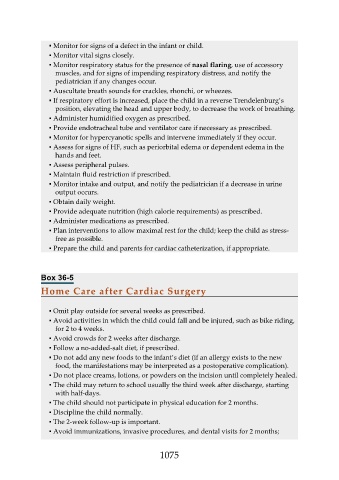Page 1075 - Saunders Comprehensive Review For NCLEX-RN
P. 1075
▪ Monitor for signs of a defect in the infant or child.
▪ Monitor vital signs closely.
▪ Monitor respiratory status for the presence of nasal flaring, use of accessory
muscles, and for signs of impending respiratory distress, and notify the
pediatrician if any changes occur.
▪ Auscultate breath sounds for crackles, rhonchi, or wheezes.
▪ If respiratory effort is increased, place the child in a reverse Trendelenburg’s
position, elevating the head and upper body, to decrease the work of breathing.
▪ Administer humidified oxygen as prescribed.
▪ Provide endotracheal tube and ventilator care if necessary as prescribed.
▪ Monitor for hypercyanotic spells and intervene immediately if they occur.
▪ Assess for signs of HF, such as periorbital edema or dependent edema in the
hands and feet.
▪ Assess peripheral pulses.
▪ Maintain fluid restriction if prescribed.
▪ Monitor intake and output, and notify the pediatrician if a decrease in urine
output occurs.
▪ Obtain daily weight.
▪ Provide adequate nutrition (high calorie requirements) as prescribed.
▪ Administer medications as prescribed.
▪ Plan interventions to allow maximal rest for the child; keep the child as stress-
free as possible.
▪ Prepare the child and parents for cardiac catheterization, if appropriate.
Box 36-5
Home Care after Cardiac Surgery
▪ Omit play outside for several weeks as prescribed.
▪ Avoid activities in which the child could fall and be injured, such as bike riding,
for 2 to 4 weeks.
▪ Avoid crowds for 2 weeks after discharge.
▪ Follow a no-added-salt diet, if prescribed.
▪ Do not add any new foods to the infant’s diet (if an allergy exists to the new
food, the manifestations may be interpreted as a postoperative complication).
▪ Do not place creams, lotions, or powders on the incision until completely healed.
▪ The child may return to school usually the third week after discharge, starting
with half-days.
▪ The child should not participate in physical education for 2 months.
▪ Discipline the child normally.
▪ The 2-week follow-up is important.
▪ Avoid immunizations, invasive procedures, and dental visits for 2 months;
1075

